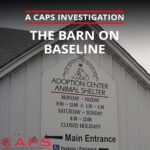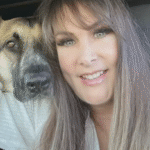Breeder: Martin, Aaron and Rhoda
Address: 26824 Vetch Ave.
City, State Zip: Pulaski, IA 52584
Year: 2006
USDA License: 42-A-0690
Date of CAPS Investigation: 2006-09-08
Time of CAPS Investigation: 16:47
On the premises at the time of the investigation: approximately 31 dogs and 9 puppies.
Breeds: West Highland Terriers, Bichon Frises, Schnauzers
Inbred puppy
Aaron and Rhoda Martin at first declined viewing of their kennel, opting instead to bring puppies out for viewing. They showed several Bichon and Westie puppies, all of which had yellow and brown stains covering soaking-wet fur. Rhoda Martin said one Westie, three months old, was the offspring of a father and daughter, saying of the puppy’s mother, “She was bred to her father.”
Inside whelping enclosures
The kennel consisted of a building with about eight elevated indoor/outdoor cages and several outdoor enclosures all on one side of the building. There was a whelping enclosure inside the building, consisting of a wire cage connected to a wire whelping box, both elevated above concrete flooring.
Next to the whelping enclosure was an elevated wire cage, about 2.5 feet long and wide and 2 feet high, overcrowded with eight Bichon and Schnauzer puppies, each about eight inches long from the tip of its nose to the base of its tail (3.6(c)(1)(i)-Primary enclosures).
When I walked into the barn with Mr. Martin, his son was picking up three puppies that had fallen out of their cage by pushing open the cage door. The puppies had crawled underneath the indoor breeding cages and into the feces and urine pooled under those cages (3.1(a)-Structure; construction) and this was why the puppies viewed earlier were so filthy.
Of the eight puppies housed in the cage, only six were shown earlier, outside, by Mr. Martin and his son, because the other two puppies were under the cage in the waste area. The puppies were placed back in their cage without being bathed; they were not even wiped off at any time during the investigative visit (2.40-Vet care).
Mr. Martin moved two Bichon puppies to a breeding cage, leaving a third Bichon puppy in a plastic dog carrier on top of the Westie whelping cage. The puppy cage had an overturned heat lamp and a can of dog food on top of it (3.1(b)-Condition and site). The top of the cage was indented and bent so that the center was three inches lower than the corners (3.1(a)-Structure; construction).
The indoor breeding cages had plastic walls and floors and thick-gauge, metal-wire roofs that were covered in cobwebs (3.1(c)(2)-Surfaces).
The dogs inside were able to push their heads completely through the mesh openings of the wire (3.1(a)-Structure; construction).
The plastic surfaces of the boxes had brown, dingy build-up on their inside and outside surfaces (3.1(c)(3)-Surfaces). Plastic self-feeders were attached to the box walls.
Outside whelping cages
The outside cages had treated-wire floorings, untreated-wire walls and ceilings, and plastic back walls with metal doggie doors connecting them to the inside of the building. Each cage contained two dogs, with one housing a nursing Bichon mother and two puppies. The puppies’ legs dropped through the mesh openings of the wire flooring, even though they were able to open the doggie door and access the inside cage wire flooring (3.6(a)(2)(x)-Primary enclosures). The mesh of the wire walls was large enough for the dogs to push their heads completely through (3.1(a)-structure; construction).
The plastic walls and doggie doors were covered in a dingy-brown build-up (3.1(c)(3)-Cleaning).
Wooden beams elevating the outdoor cages had peeling white paint, and the wood appeared moldy (3.1(c)(2)-Surfaces).
Metal water dishes in each cage had a brown build-up on their inside surfaces (3.10-Watering).
Several weeks’ accumulation of feces was under each cage and flies swarmed the area (3.11(a)-Cleaning of primary enclosures); (3.11(d)-Pest control).
Outdoor enclosures
The outdoor enclosures consisted of elevated cages with thick-gauge wire walls and treated-wire flooring. These enclosures, with metal roofs and plastic self-feeders attached to the cage walls, were connected to plastic boxes via metal doggie doors. There was one row of two cages and one row of six cages.
The back walls and doggie doors attached to them were covered in a brown build-up, and weeks’ accumulation of feces, swarming with flies, was present under each cage (3.1(c)(3)-Surfaces); (3.11(a-Cleaning of primary enclosures); (3.11(d)-Pest control).
Hollow plastic PVC pipes running through adjacent cages served as a drinking water trough for the dogs in those cages.. There was green algae and thick brown sludge covering the inside and a brown build-up on the outside of the pipes (3.10-Watering).
Wooden beams supporting the elevated cages had peeling white paint (3.1(c)(2)-Surfaces) and a brown build-up on the inside front surfaces, as did the inside surfaces of the wooden door frames (3.1(c)(3)-Surfaces).
The door of one cage had a wire about six inches long broken and bent 90 degrees inward into the cage (3.1(c)(1)(ii)-Surfaces). Two Bichons housed in one cage had mats in their fur, especially thick on the dogs’ undersides (2.40-Vet care).




